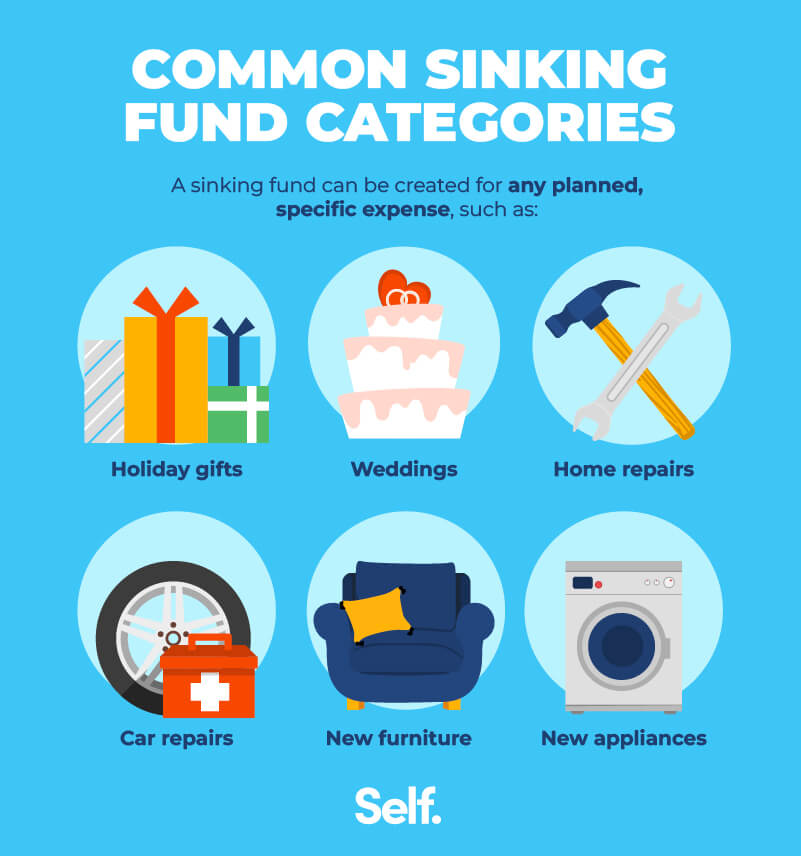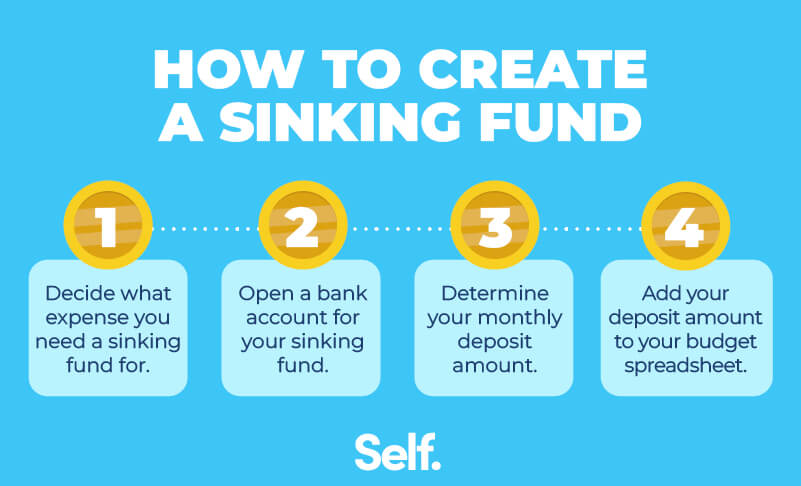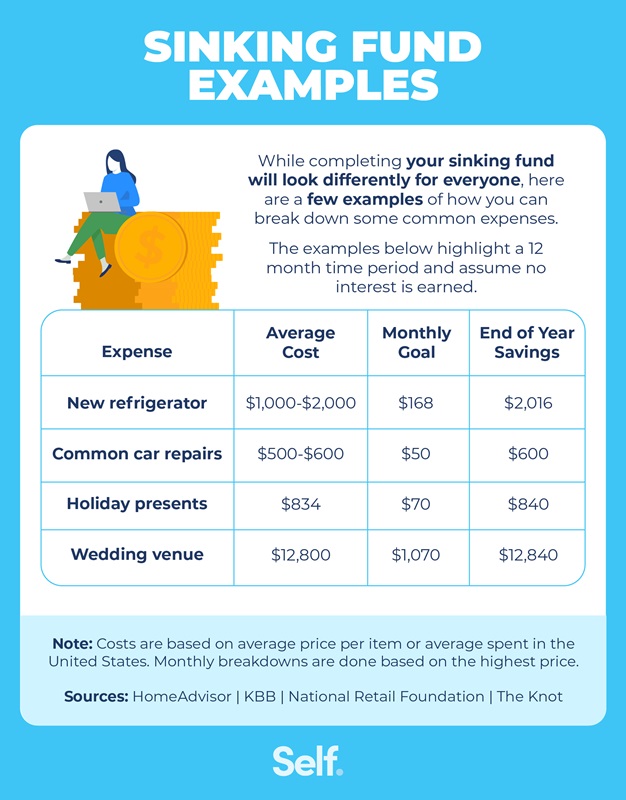What Is a Sinking Fund and How to Start One
By Ana Gonzalez-Ribeiro, MBA, AFC®
Published on: 09/03/2024
Published on: 09/03/2024
Large purchases can feel daunting, especially if they’re not in your budget. That’s where sinking funds come in. They help you plan and save for specific wants or needs.
This article discusses how sinking funds work and how you can start your own.
The term "sinking" doesn't refer to anything negative about the fund; rather it refers to the decreasing amount of debt as you work toward saving for your particular goal.
An emergency fund is designed to cover unexpected expenses like medical bills or loss of income. An emergency fund should always have a certain amount in it, ideally six to twelve months’ worth of living expenses.
It is important to note that one can have many sinking funds — one for each planned expense. Examples could include family birthdays, Christmas presents, vacations, or new furniture. Having money set aside in sinking funds can make it easier to save for these expenses over time and help achieve multiple goals at once.

If you’re not dealing with earned interest, simply divide your savings goal by your expected time period to determine your monthly contribution.[1]

You may wish to choose an online bank, as they traditionally offer high-yield savings accounts with interest rates up to 10 times higher than the national average.[2] Some banks will allow you to open multiple accounts or pots for different sinking funds, just be wary of any minimum balance requirements.
By using a bank other than your primary bank, your sinking fund will be out of sight and — ideally — out of mind, to prevent the temptation to dip into it.
For example, say your high-yield savings account has a 1.4% APY and compounds monthly. To save $20,000 in four years, you’d need to contribute about $405 per month.
If that doesn’t seem doable, it’s worth revisiting the cost of the car and the timeline in which you want to buy to make sure you can fit the purchase into your budget.
Most budget guidelines suggest devoting at least 20% of your monthly income to savings needs. Note that this includes all savings, not just your sinking fund.

Sources [3] [4] [5] [6]
Pros:
Be sure you aren’t stretching your finances too thin by chasing too many financial goals at once. Remember, intelligent finances can often lead to greater financial health.
Sinking funds not only provide powerful incentives to meet personal financial goals, but they also help teach about patience and letting your money work for you. When paired with savings accounts with higher interest rates, sinking funds can help people reach their financial goals — without adding to or impacting their debts.
This article discusses how sinking funds work and how you can start your own.
What is a sinking fund?
A sinking fund is a separate savings account opened for a specific need and term. Sinking funds are meant to be spent once enough funds are saved for the stated goal. They are used for planned, one-time expenses like home upgrades or lump-sum car insurance premiums.The term "sinking" doesn't refer to anything negative about the fund; rather it refers to the decreasing amount of debt as you work toward saving for your particular goal.
Sinking funds vs. emergency funds
Sinking funds should not be confused with emergency funds.An emergency fund is designed to cover unexpected expenses like medical bills or loss of income. An emergency fund should always have a certain amount in it, ideally six to twelve months’ worth of living expenses.
Sinking funds vs. savings accounts
A sinking fund is a form of a savings account. The big difference is that a sinking fund is designed around one specific planned expense. In contrast, a savings account is just meant to set aside money instead of spending it.It is important to note that one can have many sinking funds — one for each planned expense. Examples could include family birthdays, Christmas presents, vacations, or new furniture. Having money set aside in sinking funds can make it easier to save for these expenses over time and help achieve multiple goals at once.
How does a sinking fund work?
A sinking fund works by establishing goals. These goals can vary in scope, but it is crucial to identify their order of importance. Your sinking funds should focus on the most important goals first. Consider how much money you can put away out of each paycheck for each goal and how long it will take to save up for the needed amount. Now you have the basis for a sinking fund.Sinking fund categories
Sinking funds can be established for just about any planned need. However, always remember: each sinking fund must stay devoted to one expected goal to ensure optimal success.
- New car: Set aside a planned amount of money each month until you have enough to buy your new car.
- Christmas gifts: Plan your fund based on significant holiday gifts and begin saving well in advance.
- Car maintenance: If you know your car will need specific repairs at some point in the future like new tires (not emergency repairs), start saving and avoid the headache of paying for it when it’s time.
- Down payments: Down payments are great candidates for sinking funds, as they require financial dedication over a period of time to achieve.
- Home repairs: As in the case of planned car repair, sinking funds can ensure that home repair needs are taken care of before they reach emergency status.
- Other planned expenses: Anything with a purchase plan, including weddings or vacations, can be financed by a sinking fund.
How much money should you put in a sinking fund?
Every sinking fund will demand a different savings goal. But, for any goal, your target amount can be established through four steps.[1]- Determine how much you need to save.
- Establish your time period to achieve your goal (typically several months or years).
- Include any returns that will be reinvested, like interest your bank pays you on your savings account.
- From these details, calculate the monthly payments needed to reach your goals. This can be calculated using the following formula:
If you’re not dealing with earned interest, simply divide your savings goal by your expected time period to determine your monthly contribution.[1]
How to create a sinking fund
With a few straightforward steps, you can create your own sinking funds to meet your goals.
1. Decide how the sinking funds will be used
The first step of any sinking fund is to determine what you’re saving for. This goal must be specific and researched to ensure you save enough money. You should also plan the number of months you’d ideally like to take to save your desired amount, especially in time-sensitive cases like wedding sinking funds.2. Create a bank account to store your money
Next, choose if you’d like to open a new bank account. Your sinking fund should be separate from your checking account and your emergency fund.You may wish to choose an online bank, as they traditionally offer high-yield savings accounts with interest rates up to 10 times higher than the national average.[2] Some banks will allow you to open multiple accounts or pots for different sinking funds, just be wary of any minimum balance requirements.
By using a bank other than your primary bank, your sinking fund will be out of sight and — ideally — out of mind, to prevent the temptation to dip into it.
3. Determine a savings goal amount
Once you’ve found an account, use the above formula to determine how much you need to contribute. Be sure your goal covers all known expenses related to your needs. For example, if you’re planning a wedding there are multiple line items you need to keep in mind from the photographer to the venue.What to use a sinking fund for - examples
Sinking funds can be established for many different savings needs. For example, a sinking fund can be used to set aside monthly deposits to save up for a new car. Let’s say the car you want is $20,000, including taxes and fees. And, you want to purchase it within the next four years. Some quick math would look like:- Monthly savings contribution = $20,000 / 48 months = $416.66
For example, say your high-yield savings account has a 1.4% APY and compounds monthly. To save $20,000 in four years, you’d need to contribute about $405 per month.
If that doesn’t seem doable, it’s worth revisiting the cost of the car and the timeline in which you want to buy to make sure you can fit the purchase into your budget.
Most budget guidelines suggest devoting at least 20% of your monthly income to savings needs. Note that this includes all savings, not just your sinking fund.

Sources [3] [4] [5] [6]
Pros and cons of sinking funds
Sinking funds are more advantageous than they are disadvantageous for people who wish to work toward saving money for a specific goal.Pros:
- Allows for debt-free spending: Saving beforehand ensures that you won’t need any additional financing to meet your goals.
- Teaches good financial habits: Sinking funds showcase the importance of patience and how money can grow over time.
- You can make your money work for you: Many savings options earn balance yields every month, quarter, or year. The higher the balance of the fund, the more interest it earns.
- Temptation to spend: It can be difficult to ignore a growing account balance, especially if other financial needs arise. An emergency fund can help pay for unexpected expenses and reduce the temptation to dip into your sinking fund.
- Saving can take a long time: Sinking funds will not create overnight wealth; they are designed to build funds over time.
Should you have multiple sinking funds?
You can have as many different sinking funds as you’d like — it depends on your own goals and if your personal finances can support your goals. Whether you have one or three sinking funds, they will only be successful if they remain untouched until their “maturity date,” or when you’ve reached your savings goal.Be sure you aren’t stretching your finances too thin by chasing too many financial goals at once. Remember, intelligent finances can often lead to greater financial health.
Make sinking funds work for you
Sinking funds are great tools for those looking to make large purchases without going into long-term debt. As they are fueled entirely by your own funds, the money accrued in a sinking fund comes without any strings attached.Sinking funds not only provide powerful incentives to meet personal financial goals, but they also help teach about patience and letting your money work for you. When paired with savings accounts with higher interest rates, sinking funds can help people reach their financial goals — without adding to or impacting their debts.
Sources
- Good Calculators. “Sinking Fund Calculator,” https://goodcalculators.com/sinking-fund-calculator/
- CNET. “Why Online Banks Can Offer Higher Interest Rates” https://www.cnet.com/personal-finance/banking/advice/why-online-banks-can-offer-higher-interest-rates/
- HomeAdvisor. “How Much Does Refrigerator Installation Cost?” https://www.homeadvisor.com/cost/kitchens/install-fridge/
- KBB. “Average Vehicle Repair Costs” https://www.kbb.com/car-advice/average-vehicle-repair-costs/
- National Retail Federation. “Winter Holidays Data Center,” https://nrf.com/topics/holiday-and-seasonal-trends/winter-holidays/winter-holidays-data-center
- The Knot. “Real Wedding Study” https://www.theknot.com/content/wedding-data-insights/real-weddings-study
About the author
Ana Gonzalez-Ribeiro, MBA, AFC® is an Accredited Financial Counselor® and a Bilingual Personal Finance Writer and Educator dedicated to helping populations that need financial literacy and counseling. Her informative articles have been published in various news outlets and websites including Huffington Post, Fidelity, Fox Business News, MSN and Yahoo Finance. She also founded the personal financial and motivational site www.AcetheJourney.com and translated into Spanish the book, Financial Advice for Blue Collar America by Kathryn B. Hauer, CFP. Ana teaches Spanish or English personal finance courses on behalf of the W!SE (Working In Support of Education) program has taught workshops for nonprofits in NYC.Editorial policy
Our goal at Self is to provide readers with current and unbiased information on credit, financial health, and related topics. This content is based on research and other related articles from trusted sources. All content at Self is written by experienced contributors in the finance industry and reviewed by an accredited person(s).
Written on September 3, 2024
Self is a venture-backed startup that helps people build credit and savings.
Self does not provide financial advice. The content on this page provides general consumer information and is not intended for legal, financial, or regulatory guidance. The content presented does not reflect the view of Self's issuing partner banks. Although this information may include references to third-party resources or content, Self does not endorse or guarantee the accuracy of this third-party information. Any Self product links are advertisements for Self products. Please consider the date of publishing for Self’s original content and any affiliated content to best understand their contexts. All trademarks and brand names belong to their respective owners and do not represent endorsements of any kind.